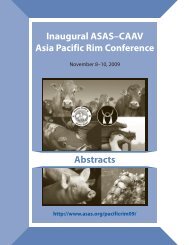BREEDING AND GENETICS - American Society of Animal Science
BREEDING AND GENETICS - American Society of Animal Science
BREEDING AND GENETICS - American Society of Animal Science
You also want an ePaper? Increase the reach of your titles
YUMPU automatically turns print PDFs into web optimized ePapers that Google loves.
292 Quantitative trait locus (QTL) analysis <strong>of</strong> the<br />
bovine butyrophilin gene. A. Zegeye* 1 , M. Ashwell 2 , C.<br />
Rexroad 2 , and I. H. Mather 1 , 1 University <strong>of</strong> Maryland, College Park,<br />
2 ARS-USDA, Beltsville, MD.<br />
Bovine butyrophilin (bBTN) is a mammary specific protein that is expressed<br />
during late pregnancy and lactation. It localizes to the apical<br />
surface <strong>of</strong> secretory epithelial cells, and is enriched in the milk-fatglobule<br />
membrane. It possesses two exoplasmic Ig-like loops that share<br />
significant homology with the B7 immune molecules. Moreover, the<br />
gene encoding bBTN is found in the MHCI cluster. The cytoplasmic<br />
tail contains the conserved domain called B30.2 that is also found in<br />
other proteins. The tissue specificity <strong>of</strong> bBTN, the structural homology<br />
with other proteins, and the chromosomal localization <strong>of</strong> the gene point<br />
to possible roles for bBTN in lactation: in milk secretion and/or immunity.<br />
The allelic substitution effects <strong>of</strong> bBTN on milk production and<br />
udder health traits were investigated. Five intragenic molecular markers<br />
in the form <strong>of</strong> PCR restriction fragment length polymorphisms (RFLPs)<br />
were first identified: three within introns A and D, and two within exons<br />
4 and 7. These markers were used to genotype grandsires and their sons<br />
from a granddaughter design. A QTL analysis was conducted to identify<br />
associations between bBTN and milk production and health traits<br />
as per the model described by Ashwell et al. (Ashwell, M. et al., 1997,<br />
Anim. Genet., 28, 216–222). Three grandsire families with a minimum<br />
<strong>of</strong> 56 sons were used in the analysis. Seven traits were considered: milk<br />
yield, milk fat yield, protein yield, % fat, % protein, somatic cell score<br />
(SCS) and productive herd life. Most <strong>of</strong> the alleles showed no statistically<br />
significant effect (P.05) between MFPD or PTA M values <strong>of</strong> the groups. Group 3 was<br />
excluded from analysis because only one individual had this haplotype.<br />
Even though the MspI site in intron 3 is located near a transcription<br />
factor binding site and the MspI (+−) is associated with a .9 kb insertion/deletion<br />
in the 3’ flanking region, potentially carrying transcription<br />
regulator sites, neither this, nor the AluI(+−) or the presence <strong>of</strong> both<br />
MspI(+−)/AluI(+−) in the current study resulted in difference in indicators<br />
<strong>of</strong> genetic merit.<br />
Key Words: Selection Marker, RFLP, Genetic Marker<br />
J. Anim. Sci. Vol. 76, Suppl. 1/J. Dairy Sci. Vol. 81, Suppl. 1/1998 75
















